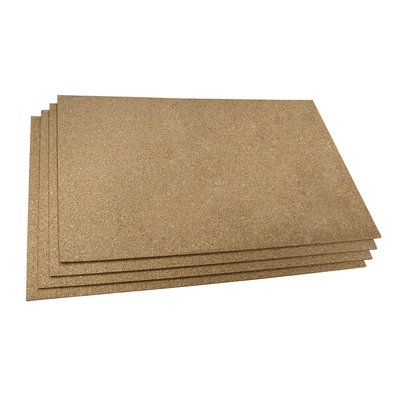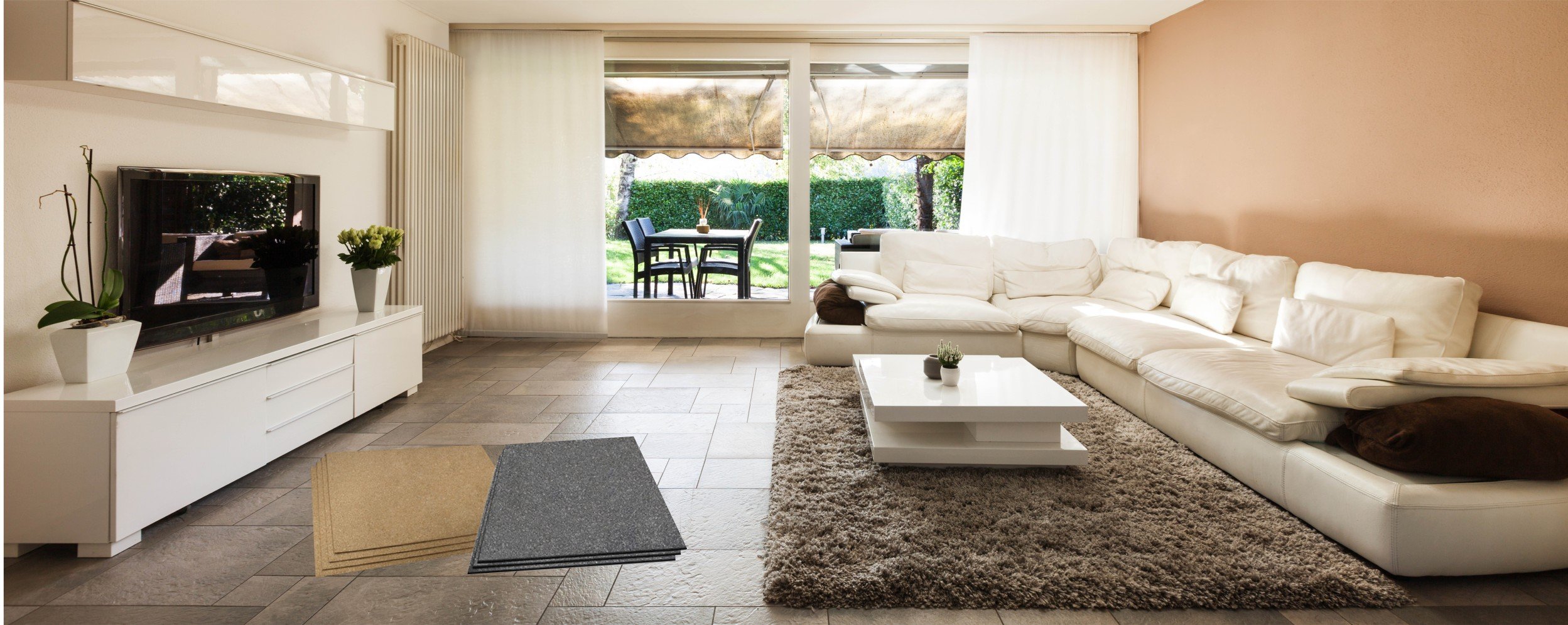In the world of in-floor heating, manufacturers are breaking ground with new products and installation techniques all the time. It’s an exciting time to be in the industry, but it can also be difficult for trade pros to keep up with all the new developments. Oftentimes, that means something goes on the back burner. Usually it’s underlayments because of the assumption that they are only required for use over concrete subfloors to prevent heat loss. However, this neglects the fact that almost every project could benefit from including an underlayment. Each one has its own unique properties, benefits, and best application.
To help trade pros stay up to date on available types of underlayment and when to use them, WarmlyYours has compiled this guide.

Cork Underlayment - Economical & Perfect for Environ
Cork is the traditional, most well-known choice for underlayment. It’s known for its excellent insulation properties, which is vital when it comes to creating a barrier between a radiant heating system and a cold concrete slab. The last thing you want is heat loss when you're installing an in-floor heating system. Cork underlayment is also durable, lightweight, easy to install, and the most affordable underlayment option. What makes it a perfect fit for WarmlyYours’s Environ™ floor-heating system, however, is the fact that it is 1/4-inch thick, which is enough to hide the system’s cold lead. Plus, cork has a slightly lower R-value (aka insulating factor) than synthetic cork, which bodes well for carpet, laminate and floating wood floors. Environ™ floor-heating mats were specifically designed for carpet, laminate and floating wood floors, which makes these products a match made in heaven.

Synthetic Cork Underlayment - Moisture Resistant & High R-Value
Like cork underlayment, ThermalSheet™ synthetic cork specializes in suppressing heat loss. However, it's unlike cork in that it's particularly ideal for use with a TempZone™ radiant heating system although we also recommend it for use with Environ too. ThermalSheet is unique because it will not rot, support mold or mildew, or absorb moisture.
At roughly 1/4-inch thick, it's the same thickness as cork underlayment but it has a higher R-value than cork. This is important because the TempZone™ floor heating system is designated for use under tile and stone, which are inherently cold materials. When you’re sandwiching a floor-heating system between a cold concrete slab and a cold flooring material, using an underlayment with a higher R-value is a big help.
This is because the insulating underlayment creates what's called a "thermal break" which prevents heat from being absorbed downward into the concrete slab. This in turn ensures that the energy produced by the heating elements will be directed upward and greatly increase the energy efficiency of the heating system.
ThermalSheet also offers an added benefit of providing sound proofing benefits which can be of added use when heating a room over a cold space like a garage. The insulating underlayment with prevent heat loss to the cold space below while also providing sound dampening benefits to improve peace of mind.

Prodeso™ Membrane - Provides Fast Installs & Waterproofing
For customers using free-form TempZone™ Cable, the Prodeso™ Membrane is a great option. Although it doesn't boast a significant R-value, its other benefits make it a prime underlayment contender. The Prodeso underlayment/installation membrane features rounded square-shaped reliefs to hold the cable in place during installation. This makes it the only option that allows installation to be completed in one day because the thinset does not require time to dry. It’s the fastest, easiest way to install loose cable. Furthermore, it’s the only option that can be waterproofed. By applying a waterproof tape called Prodeso ProBand to the membrane, you can waterproof the entire system when it’s placed in water-prone areas like the kitchen or bathroom.
Each of the underlayments perform the task of crack suppression to ensure that your brand-new floor isn’t damaged by a crack telegraphing upward from the concrete. Plus, you can use them over any subfloor — not just concrete — in order to increase your energy efficiency, load stability, and (in the case of Prodeso) ease of installation.
Every in-floor heating system has an appropriate underlayment, and with this guide, now you know! If you have any questions about underlayment or radiant heating in general, don't hesitate to contact us for more information!





My area to heat is large, about 190 sq ft total, so I need to get the cable and Prodeso mat, but it’s also on concrete slab, so I need an insulation barrier. Can I do both?
That's a great question and, yes, you can use both the Prodeso Cable Installation Membrane and the CeraZorb insulation underlayment together to install your TempZone Floor Heating Cable. We have a cross section illustrating that combination (among others) that is available here: https://www.warmlyyours.com/publications/TEMPZONE-CABLE-PRODESO-HEAT-MEMBRANE-CROSS-SECTION-A
We just had radiant heat added to our addition, but the concrete floor was not quite up to the existing floor. So now we have to use an underlayment on top of the heated floor and then we are going to add a new floor. What is the best underlayment to use? Plywood or one of the ones you talk about on this page. Thanks
Thanks for the interesting question. Just to be clear, we don't recommend that anyone install anything on top of a heated floor as it can negatively impact the performance of the heating system. We recommend that the heating element is installed between 1 and 1.5 inches from the finished flooring surface, otherwise the system may not deliver satisfactory heating. If the heating wire in the situation you outlined would still be within 1.5 inches from the finished flooring surface, then we would recommend that you use an underlayment with as low of an R-value as possible, like Self Leveling Cement, to build up the floor, but again, we don't recommend installing anything overtop of a heated floor. If you have any further questions, please don't hesitate to give us a call at 1-800-875-5285.
We have radiant heating installed in our cement slab. We are installing an engineered wood flooring. The cement was poured over a vapor barrier. Is there an underlayment that can be used that will not block the radiant heat transmission? Thank you
That's a great question. For the situation you outlined, you'll need to find an underlayment with a low R-value that will be installed between the slab and the floor covering. The R-value of an underlayment represents the level of thermal resistance it has, so the lower the R-value, the easier it will be for the heat to radiate from your embedded heating system into the rest of the room. You can typically find an underlyament's R-value by checking out a "technical specifications" sheet for the product or by contacting the manufacturer directly. We hope that helps!
We have basement height limitation -so the subfloor and heated assembly has 2 needs- 1. Limit the total thickness of underlayment + heating mat/cable/membrane 2. Optimize the insulation from basement slab (uninsulated slab). If I have about 13-15mm (max 9/16”) to work with, what system would you suggest?
The situation you've outlined is a pretty challenging one. If you only have 9/16" for both the heating element and the insulating underlayment, we would recommend using our Environ heating elements with cork underlayment underneath a floating floor. The cork is about a quarter of an inch thick while the heating element is about 1/16th thick, which would mean an overall thickness of about 5/16". If you have any other questions, don't hesitate to give our Radiant Experts a call at 1-800-875-5285.
Hello! We plan to install radiant heating underneath a laminate tile floor. The 'underlayment' at this point is dated vinyl flooring from the 1960s. Do you recommend first removing the vinyl flooring and then adding a new underlayment, or can we install an underlayment above the old vinyl flooring? Better yet, can the vinyl flooring actually act as the underlayment?
That's a great question! The bad news is that your old vinyl flooring can't act as the underlayment for the type of floor heating system used with laminate tile. However, the good news is that you don't have to tear it up. You can simply install the underlayment (we would recommend cork) over the existing floor and then install your floor heating system (we would recommend our Environ Flex Rolls) before putting on the laminate tile. Hope that helps!
Can the heat element be placed on vapor barrier attached to cork underlayment or will it heat up and melt the vapor barrier? Using eco cork friendly 10 in 1 system under LVT.
It's always best practice to consult the underlayment manufacturer since they might have information that we're not privy to but from what you've outlined, it shouldn't be an issue since the vapor barrier will likely be between the subfloor and the cork underlayment. So the heating elements (which will probably be embedded in thinset since you're using LVT as the floor covering) will be separated from the vapor barrier by the cork underlayment that will function as a thermal break. Hope that helps!
Hi WarmlyYours team! We have a plywood subfloor and are installing grooved plywood panels on top of it, with aluminum heat transfer plates, to lay radiant tubing in. We then are installing engineered hardwood on top of the radiant panels. My question is - should we install 1/4" thick cork underlayment between the radiant panels/tubing and the engineered hardwood floor planks? I am interested in the sound dampening and walk-softening advantages of the cork underlayment, but I don't know if there will be issues with having it between the radiant and the engineered planks. What do you recommend?
Thanks for reaching out with this very interesting question! First and foremost, it sounds like you're installing a hydronic system (we specialize in electric floor heating systems) so you'll want to consult with the system's manufacturer just to confirm. But from our experience, you wouldn't want to put an underlayment like cork between the heating system and the finished floor covering. This is because cork does have insulating properties (its degree of thermal resistance is not as high as say CeraZorb but it's still an insulator) and it will negatively impact the effectiveness of your heating system. Hope that helps!
Hi, we have a concrete slab in our basement bathroom and have purchased a floor heat mat manufactured with integrated heating wires. I would like to know which underlayment (thinnest possible) is recommended for under the mat. We will be installing ceramic tile as the floor covering. Thanks in advance!
Thanks for reading and for submitting this question! CeraZorb, a synthetic cork underlayment, is probably your best bet for use as an underlayment since it has roughly twice the R-value of natural cork and it's very thin (just under 1/4"). Hope that helps but if you have any further questions, please don't hesitate to give us a call at 1-800-875-5285.